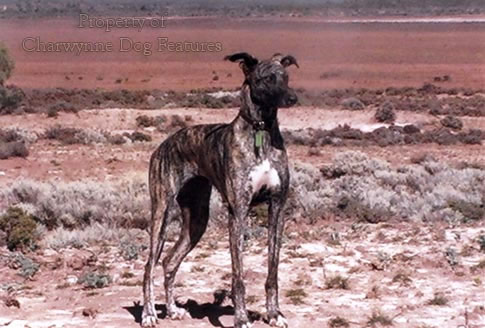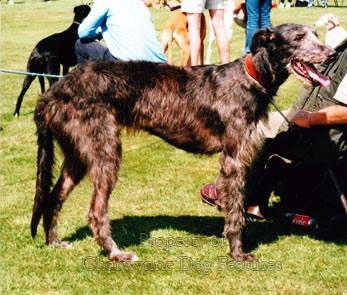653 Keeping the Blood
KEEPING THE BLOOD
by David Hancock
 "I have tried greyhounds but they are no good in rough country, too easily hurt. Deerhounds are the tops; gave up borzois after five years, too temperamental (like the Russians). Wolfhounds can be very game but are not fast enough. Afghans are a write-off, too much coat and no brains. Salukis are a lovely hound, fast and tough but they are the only breed of dog I could not control, could not get 'through' to them."
"I have tried greyhounds but they are no good in rough country, too easily hurt. Deerhounds are the tops; gave up borzois after five years, too temperamental (like the Russians). Wolfhounds can be very game but are not fast enough. Afghans are a write-off, too much coat and no brains. Salukis are a lovely hound, fast and tough but they are the only breed of dog I could not control, could not get 'through' to them."
Those words from an experienced Australian hunter of 'roos, emus, feral pig and foxes, of nearly fifty years ago are worth heeding. But they apply to his terrain, his quarry and his climate; lurchermen here know that they need a different dog on different quarry, although the dreaded hunting ban has limited the latter. Who now, for legally-taken quarry, needs a lurcher over 24 inches at the withers? Who now needs a dog capable of bringing down the bigger quarry?
Will we ever again need the type of instinctive hunting technique described by Sobieski in his Lays of the Deer Forest of 1848, when he wrote: "The experienced greyhounds rarely run at the deer's neck but come up close by his flank, and shoot up at his throat, too close for the blow of his horns, and to effect this they will sometimes for several yards run by his haunch until the favourable moment for making this launch at his neck. There are, however, dogs which have peculiar modes of attack. Thus some will seize the deer by the fetlock, and one hound mnamed Factor, a small but very fleet and highly couraged dog, was accustomed to make a spring over the deer's croup and fix himself upon the nape of his neck, when he never failed to bring him down."
There is a dilemma here for the 'bleeding hearts brigade'; which gives the greater potential suffering on a deer cull, the possibility of maiming from long range or the certainty of seizing at close range? Animal welfare sadly is so often much more linked with a prejudice against hunting than truly and honestly about reducing animal suffering. Academics who don't approve of hunting don't always approve of truth and accuracy either. I recently read a thick tome on post-medieval Germany and was alarmed to discover that not only was hunting not mentioned in the index but didn't feature in the text! The book covered a period of German history when their leaders went hunting six days out of seven! Did that have absolutely no impact on who they entertained, who they spoke to on a daily basis, how decisions were reached, how social life developed? Selective scholarship deceives, perhaps knowingly.
Which feature is of the greater value to the reduction of suffering in animals that have to be controlled, the Foxhound which can kill a fox with one bite or a so-called 'marksman' who can maim at long distance? Which pig being driven to the slaughter house suffers more, one urged on by a cattle-probe or one driven by dogs? Which harms African wild hooved-game more, being chased by a low-flying helicopter, darted with drugs and then tagged or, being 'seized' by a strapping hunting dog and then tagged? The broad-mouthed 'holding' dogs can seize and hold quarry and not leave a mark on it. Soon blind prejudice not knowledge or prowess will triumph and we will lose hunting dogs with irreplaceable skills. There is sense surely in retaining their blood, keeping the lines going, as the saying goes.
In his book Hunters All (Huddlesford, 1986), Brian Plummer describes Phil Lloyd's way of catching deer; 'Lloyd perfected his own technique of deer poaching allowing his dog a hock hold and nothing more, training his dogs by allowing them to 'bulldog' Hereford calves until they had developed the technique of pinning a deer without damaging it, so that Phil could despatch the beast quickly, quietly and above all, humanely.' The act was illegal but the skill displayed by the dog was remarkable and a skill surely of value today in wildlife conservation work, when tagging or emergency treatment is deemed necessary. Most dogs want to work, it is the human int ent which directs that urge to beneficial purposes. Dogs which earn their keep are always better valued.
ent which directs that urge to beneficial purposes. Dogs which earn their keep are always better valued.
In the early nineteenth century, William Scrope had the freedom of the Atholl deer forest, to kill the venison needed for the castle, to run the drives for the castle's guests and to conduct culls when needed. Unable to obtain efficient pure Deerhounds, he resorted to a cross between the Foxhound and the Greyhound, with great success. Scrope recorded that the head stalker, a Mr John Crerar, had tried various crosses over sixty years, but found this mix incomparably the best. Scrope wrote that 'the greyhound cannot stand the weather, and wants courage...and they have no nose...The foxhound is equally objectionable; he has not sufficient speed, gives tongue and hunts too much by scent; in this way he spreads alarm through the forest.' But he stressed the need to re-breed the hybrids NOT to 'continue to breed from the produce first obtained'. That is an interesting point for lurcher breeders seeking to capitalise on proven stock. 
In her absorbing book, The Grunter Hunters (Halcyon Press, 1992) Kim Swan describes how feral pig is controlled in New Zealand using brave and determined dogs. The boar she hunts can weigh over 250 lbs and frequently kill hunting dogs. She and her fellow hunters use boar-lurchers: Bull Terrier and Bullmastiff crosses, Rottweiler blood and a regular infusion of cattle dog blood too. Feral pig do enormous damage to farmland in New Zealand, they are not native species, but are descended from domestic pigs which have escaped, gone wild and interbred, perhaps from 14 different types or breeds of domestic pig. The dogs have to be immensely courageous, extraordinarily agile, extremely resolute and supremely athletic - or they die! When the wild boar population here needs culling, it would be best done using seizing dogs, that is, if we haven't destroyed all those with strong heads and displaying 'persistence', as the police and RSPCA like to term it!
Currently, the lurcher which best earns its keep is probably the rabbit-dog working to the lamp. The great George Smith has written on this subject: 'As regards the breeding of lurchers for lamping this, like so much to do with lurchers, is a matter of opinion. But the best lamping dogs I have ever had were 'Lass', who carried Staffordshire bull terrier, whippet and greyhound blood; 'Spring', a Bedlington-greyhound; 'Fin', who looked deerhound-greyhound but had everything else besides, and stood nearly 30 inches at the shoulder; and one pure greyhound. As I have said, many people favour the small greyhound-collie for lamping but the truth is that the really good dog will do his work, no matter what he looks like.' Whatever its use, the 'really good dog' will always triumph, whatever its size; keeping that blood alive is of paramount importance.